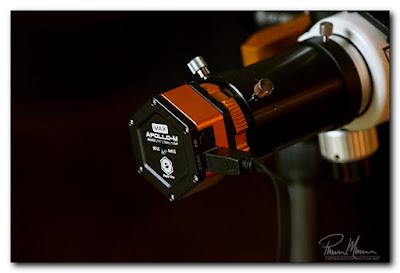Solar Astronomy Camera
I finally purchased a much needed dedicated solar astronomy camera and it arrived last night!
I've been using a sort of generic beginner astronomy camera (well... maybe one step above entry level) meant primarily for guide scopes and planetary imaging. There are far worse cameras than the one I've been using until now but this camera is not really an ideal choice for solar imaging. It has been slow, difficult to use, noisy, and the image quality has been seriously lacking. Producing good results out of this old astronomy camera has been difficult, frustrating and requiring a lot of extra post-processing. I've had to work very hard at finessing fine detail out of the images and I've only managed to succeed at doing that because of my decades of photography experience. I admit that I've managed to produce some nice imagery with the old camera but it has been difficult to accomplish requiring a lot of extra work and time. Plus, much of the data from the old camera was usually unusable.
Last night, I opened up the box that the camera arrived in to make sure everything looked good. The camera was smaller than I expected which is good. I don't need a big heavy camera hanging off the end of my telescopes. The camera appeared to be in perfect "new" condition. It shipped directly from China so it made a very long trip in just a few short days. The longer the trip, the more likely there would be damage due to shipping. Fortunately, everything looked to be in perfect order.
The camera is a Player One Apollo M-Max monochrome solar camera. I chose this particular camera (and it is brand new to the market) because it has a few features that make it ideal for solar astronomy.
First, it is a monochrome camera. Solar imaging is typically done in one specific wavelength of light so a color sensor doesn't work well because two thirds of the sensor pixels do not record anything. For instance, if I am imaging in the red wavelength, none of the blue and green pixels will record any data. Only the red pixels will record data. All of the pixels on monochrome sensors, on the other hand, record shades of light regardless of and instead of color. Monochrome sensors are needed for solar imaging.
Another plus of this new camera is it is fast. It is far faster than any of my other cameras. The sun changes quickly so a fast camera is necessary.
Another plus is that these pixels are big... they are huge in size! My old monochrome camera has pixels that are 2.4 microns in size. This new camera has pixels that are 9.0 microns in size which is ideal for the type of imaging I will be doing.
Another great feature is this camera is very unique in that is has a tilt plate. When a solar camera is perfectly square to the telescope's image, you end up with what is called Newton Rings. Newton Rings can be compared to a moire pattern that is normally seen in normal photography. If the camera/sensor is slightly tilted, you can eliminate those Newton Rings. This camera will allow me to tilt the sensor at no extra cost which saves me about $200.
This camera also came with an active cooling system to keep the sensor cool. As sensors capture frames, they heat up and produce a lot of noise (image noise, not audible noise). The active cooling system will keep the sensor cooler and the images clean and relatively noise-free.
Today, my plan was to test this new camera so I inserted the camera into the focuser of my smallest telescope and pointed the telescope out our living room window. After booting up my laptop, I connected the camera to the laptop and started up SharpCap Pro so I could control the camera and capture some images.
The moment the camera connected to the software, the image on the screen looked far, far better than anything my previous camera produced! I have to say I was amazed at how nice this image of a distant mountaintop looked on the screen.
After adjusting the focus and exposure, I clicked on the "Quick Capture" button and chose for it to do a quick run of 100 frames. Shooting 100 frames with my old camera took about 15-20 seconds. This new camera shot 100 frames before I even moved my cursor off the "Quick Capture" button. That took less than one second to capture 100 frames! Again, I was amazed.
Below is one of the 100 frames of the distant mountaintop that I shot with the new camera. I was focused on the mountaintop ridge. The blurriness, here and there across the frame, is trees in the foreground closer to our house. For an astronomy camera, this is an excellent image...
I'm really looking forward to testing this camera on the sun. This camera should produce far better results than I have been getting and I'm confident it will be far easier to produce great results.


Comments
Post a Comment